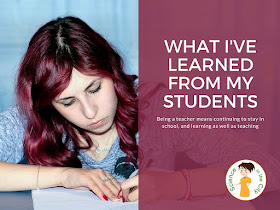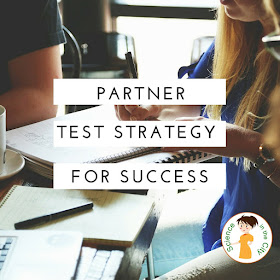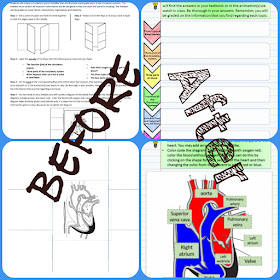What kind of classroom routines do you put in place? As the year wraps up, I think it is a critical time to think about classroom expectations and routines that you want to change for next year. It is also a good time to try out a new procedure or routine that you are thinking about for next year.
I know its a hard time of year to think about that, but its worth it. If there is a classroom ritual or routine that you have been thinking about implementing, but aren't sure, this can be a good time to try it out.
Think of it as a pilot program :). Granted, some things are different at the end of the year than the start, but it gives you a chance to get a feel for what you want to try, and then think about changes that you want to make for the upcoming year.
In the past I have changed my homework policy for the last unit or last marking period. I have tried a positive behavior incentive system (it doubles as a good way to keep students motivated at the end of the year). I have also changed how I did the start of class, or the end of class. Here is a starting point for reading about behavior incentive systems. I know they are controversial, and can be problematic, but they can also be helpful. Along with this, another behavior system to try can be classdojo.com. If you haven't heard of classdojo yet, and have a class that is struggling with either behavior or just is not really engaged and motivated, it can be a great tool. You may want to check it out! Both of these systems take some work and adjustment on the teacher's part, so the trial period/pilot program is a great time to see how you like it, and if it will work for you, or what you want to adjust.
Another area you may want to experiment with is how you start or end class. It is so important to teach students not to waste time in class, and to come in 'ready to go.' Part of this means being on time, but it also means engaging your brain at the start of class. Whether its a quiz on yesterday's class, an open-ended question to get thinking about today's topic. If you use a timer, it becomes a way to really keep students focused and get on task at the start of class. It is also important to give some students some closure at the end of class, and for both you and they to get a good understanding of their learning and comprehension.
I do think through both warm-ups/bell work and exit tickets. Over the years I have done warm ups on a smart board or even an overhead (gasp!), and had students answer on paper. When I did it that way, a big time saver is this bell work sheet. It will save you time at the copier, and also save time grading, and save class time as students aren't scrambling for paper to write on.
If you are thinking about using Google Forms or Google classroom, they are another great way to do warm ups or tickets out. I have created a set of warm-up/tickets out in Google Forms that you could try out. I also have the same set of warm ups in Google Slides and an PDF's, if you prefer to project them, do them on paper. These will eventually be part of a growing bundle of warm ups and tickets out on various topics to use throughout the year (should be posted this weekend).
If you are thinking about trying out different seating arrangements, use editable seating templates to get some ideas going.
Finally, if what you really want is general tickets out, that are not topic specific, check out this freebie. Tickets out can be used for reflection, formative assessment, or closure on a lesson. These four freebies are part of a larger pack that is NOT subject specific and can be used in so many different ways.
If you are looking for a timer, to use for bellwork, I have used several free options. Within the chrome browser is this extension for 1-click timer. If you use the Smartboard you probably already know that there is built in timer. If you are looking for a freestanding time in Windows here is good one. It is 'portable' which means that you don't need to install anything (say on a district computer where you can't install) to use it.
Hope some of these ideas were helpful, and give you a little bit of perspective on your classroom routines at this point in the year.
What things are you looking to change or try out?
On the website
▼
Resources
▼
Apr 29, 2016
Apr 20, 2016

Lessons My Students Taught Me That Will Make You Rethink Your Role
As a teacher, and even a veteran teacher, I learn a lot from my students (yes, I know its a cliche, but its true!)
They fill me on and make sure I learn about clothing and music trends, and which rappers and TV shows to watch. I learn about struggles that young children and teenagers have to deal with that I could never imagine, now, as an adult. I have learned what it really means to live in poverty, and gained an appreciation for the drive, ambition, and pride that some students have, against all odds. When you teach in an urban area, in a very impoverished setting, and come from a middle class background, you learn a lot.
However, across different grade levels (7th grade through college), different achievement levels (AP to credit recovery and special education), and different backgrounds, one thing sticks out to me.
Cutting across all of those groups, I think the biggest thing that I have learned is how important positive feedback and recognition is. Students will work harder in your class if they feel successful. You have the power to make sure they feel successful during class, regardless of their grade. Yes, there are ways to make lessons more fun, more relevant, more engaging, but beyond all of those students need to believe that they are appreciated, recognized and successful in class to take a risk and be a part of those activities.
Students quickly decide that they 'like' or 'hate' your class, and a lot of it has to do with feeling successful. They can also change their mind! You can control this! I don't mean by changing your expectations or your grading system.
How can you make students feel successful? Compliment them. Compliment them on the skills that you want them to continue to utilize. Reinforce the behavior that you want them to do. Reinforce when they are doing well. Praise them for using those skills and behaviors. Its a win-win -- they are feeling successful and are likely to continue or increase those behaviors.
Let me give you a couple of examples. My own son does taekwondo. At taekwondo, when he struggles with learning a particular kick or gets beaten at sparring, he sometimes doesn't want to go back. When he gets praised from the instructor, wins a contest, or gets a compliment from a peer, it makes his day. In fact, not only does it make his day, but it makes him that much more excited to go again, because he feels like he's good at it.
This same principle applies in the classroom, but now, instead of starting with a blank slate, you are starting with students who may have previous 'scars' and preconceived ideas that they are not good at school, especially be secondary school.
I have done a ticket reward system several times in my classroom over the years, depending on the group of students that I have, and the building in which I am teaching. In most cases, the students who are the most responsive to it are some of the lowest performing. Also, in most cases, they don't really want the prizes. There are a few students who are really after the prizes, but most want the points/tickets -- they want the recognition! That's not something they are used to getting in class! And when they do collect prizes, one of the most popular prizes (yes for high school and middle school students) is a positive note or phone call home.
I give tickets or points for things like getting to class on time, answering questions, taking notes, helping a classmate. These are basic classroom behaviors, but often it is our weakest students who aren't doing these things. It is part of our job to teach these steps. And then when students do them, recognize that! Then it is cyclical - as they do those behaviors they become more successful and it builds.
In thinking about praise and recognition is, and what kind of non-materials rewards we could give students I started a google search. I typed and this is what I got
I give tickets or points for things like getting to class on time, answering questions, taking notes, helping a classmate. These are basic classroom behaviors, but often it is our weakest students who aren't doing these things. It is part of our job to teach these steps. And then when students do them, recognize that! Then it is cyclical - as they do those behaviors they become more successful and it builds.
In thinking about praise and recognition is, and what kind of non-materials rewards we could give students I started a google search. I typed and this is what I got
Yep! The top result is for employees! Yes, I clicked on it. And you know what, a lot of the ideas suggested I think would be great. Everyone wants to feel appreciated, and recognized. I would love to work in a place where there were things like comp time off (does that sound similar to free time to time to listen to music in class?), or a nice card from a boss, recognition at a meeting (similar to a note home, or recognition at an assembly), a better parking spot (not so different from a special seat in class).
School shouldn't be so competitive. Who wants to come to a place every day where they don't feel successful and appreciated?! I wouldn't want to work in such an environment, and I doubt you do either. Not everyone fits into the one-size-fits-all approach that is present at schools. Part of our job as teachers is to help all students feel successful, welcome, and appreciated for who they are.
I do my little piece by greeting them by name, making positive phone calls home, recognizing in class when they are working particularly hard or helping a class mate. None of those cost a cent! A ticket or point system, I believe, is really in place to make both sides of this process (teacher and student) more tangible, and to serve as a reminder.
What do you do to help your students feel appreciated and successful in class?
Apr 12, 2016

Test Taking Strategy You Need to Know
When my students take a test, I want them to reason through the answers, read carefully, support their thinking, and make connections to what they know. Don't you?
I don't know about you, but this is not often the case. When it is the case ,it is usually for my stronger students, but my weaker students (who most need to utilize these strategies) often don't do so. Instead my weaker students are more likely to just pick answers, sometimes randomly, or even to leave questions blank.
Like many of you, I have tried many other strategies to help students develop their test taking abilities and strategies, but with limited success.
My favorite is to allow students to work with a partner. However, I don't tell them this right away. I let them work on the test for the first half the period or so. Then I will allow them to choose a partner. They have to finish the test with a partner, or use their partner to check any that they aren't sure of. Sometimes I tell them they need to turn in only one answer sheet. Sometimes I allow them to turn in two answer sheets.
The results are amazing! Students are already quiet, and for the most part engaged, but may be struggling. They are in a good spot to collaborate. All of a sudden I walk around the room and hear students saying things like,
"I think it has to be B because...."
"Well it asks us to compare, that means we have to talk about how they are alike and different"
"Did you look at the diagram?"
They suddenly have a reason to explain their thinking. They are encouraged to go back and look more closely at the question, the diagram, the vocabulary.
This works better than open notes, in my opinion because my weaker students often don't have good notes from which to pull information. Here they have a crutch, but they have to convince another person of what they know, or work together with another person to agree upon an answer.
This has been an amazing strategy in my classroom to encourage even the weaker students to work through the questions, just the way that we want them to! As they do, they learn from talking through the questions, using vocabulary, and also they gain confidence when they see what they know.
This is one of my favorite strategies. It can't be used all the time, but used sporadically it has great results. One time my kids were taking a test this way and the director of science for my district walked in. He was very impressed with the conversations that he heard taking place!
What are your best strategies to build confidence and help students learn to think through difficult questions?
Apr 5, 2016

What You Need to Know to Use Digital Interactive Notebooks
Digital Interactive Notebooks in Google Drive
As more and more schools are moving toward chromebooks, or use of Google Drive on laptops or desktop, it presents some opportunities that you may not be aware of.
Most people are aware of using Google drive for students to write a document and 'share' it with the teacher, or even to collaborate with another student to create a document together.
Google Drive can also be used to share information such as readings, slides, videos, etc.
There are countless blog posts, websites, and resources available on using Google Drive, and Google Classroom.
Google Drive and Google Classroom Resources
Here are a few resources to get you started:
- 34 Interesting ways to use Google Docs in the Classroom
- Getting Started with Google Classroom
- The Google Apps Learning Center
I have been using Google apps quite a bit over the last two schools years, but I have been stuck at times because I do things with a lot of diagrams in them, and I use interactive notebooks. I was nervous for students to have some work on the computer, and some in notebooks.
The switch to Digital Interactive Notebooks
I am making the switch to electronic INB's, with a few tweaks that I wanted to share with you
- Most INB pages can be in google slides, making it easy to combine pages, add and move pages, etc.
- If they do something on paper that can't be replicated electronically, such as a hand drawing, they can take a picture of it and insert it.
- If I have diagrams that need to be labelled or colored, this can be done.
An example of a converted resource
I converted my Circulatory System Foldable (paper version) to a Google Drive version. You can see a preview of it below:
I'm finding that students are more successful working on Google Drive because their work is automatically saved, searchable, and not lost! It eliminates the forgetting of papers, and losing papers. Also, if students are messy writers, or get frustrated with mistakes they might make, this lets them produce a neat and clean copy. If you use Google Classroom, it also is a great help with absent students. They can check there for any missing work.
Here are a few other shots of this digital product, compared to the paper copy.
Digital Notebook Resources
If you are intrigued, but not quite sure, here are a few other links to some ideas on doing interactive notebooks in Google Drive:
If you are using Google Drive, you may also want to be aware of how to use Google Chrome Extensions to help differentiate.
Click here for a free starting guide to differentiate with Google Chrome
I'd love to hear how you are using Google Drive in your classroom, or if you are doing Digital Interactive Notebooks in another way. If not, what reservations you might have. Please comment below and share your experiences.
Other Example Resources
Here are a few other resources that I've converted to Google Drive format:












